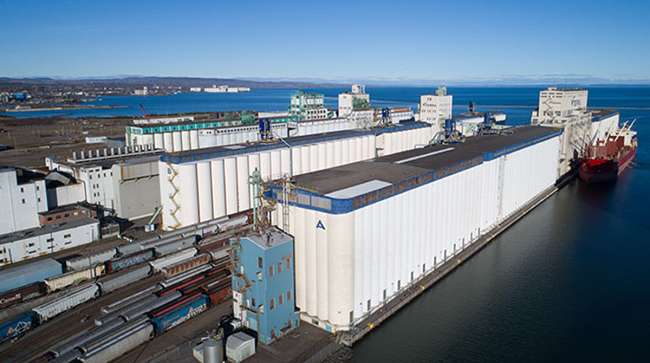Staff Reporter
Canada to Raise Capacity at Port of Thunder Bay

[Stay on top of transportation news: Get TTNews in your inbox.]
Canada is investing C$6.7 million from its National Trade Corridors Fund on two projects to improve and increase capacity at the Port of Thunder Bay, a key grain transport hub.
“Given the importance of the terminal to our country’s economy, this funding is welcome news not just for Northwestern Ontario, but also for the prairies and our entire country,” said Marcus Powlowski, a Thunder Bay-Rainy River member of Parliament.
“Today’s investment will upgrade the port and Keefer Terminal’s ability to handle goods. The terminal is a gateway to Canada. It handles a variety of items ranging from important components needed for tar sand and mining projects, to gigantic components for wind turbines, to fertilizer needed for prairie farmers,” Powlowski said.
The government investment will use money from its national C$4.6 billion trade corridors fund, meant to improve reliable trade flows globally, increase exports and maximize efficiency in Canada’s transportation system.
Pablo Rodriguez, transport minister, said the money spent on the Port of Thunder Bay will boost Canada’s overall economic competitiveness due to its ability to handle more cargo.
“Canadian businesses will benefit from better access to international markets, and Canadian consumers will keep being able to access affordable goods, when they need them,” Rodriguez commented.
In dual projects at the Port of Thunder Bay, up to C$3 million will be spent to redevelop the existing waiting area where trucks carrying freight wait for unloading at Keefer Terminal. New heavyweight rail track and switches will be added to enlarge cargo handling and improve supply chain fluidity.
The other grant (C$3.7 million) will bolster capacity by upgrading the Keefer Terminal wharf, expanding the terminal’s cargo laydown area, developing electrical infrastructure for the new laydown area and enhancing rail crossing infrastructure.
“These projects will grow the Northern Ontario economy by supporting various important industries including grain, potash, steel, wind turbine components, transformers and phosphate fertilizers,” noted a Canadian government announcement March 15.
Built to give Western Canadian grain producers access to European markets for what is billed as the longest grain supply chain in the world, Port of Thunder Bay is
Want more news? Listen to today's daily briefing above or go here for more info
located at the Western Canadian terminus of the St. Lawrence Seaway System, the largest inland waterway in the world.
Last year the port’s cargo volume was 9.6 million metric tons, which included grain (7.26 million metric tons), potash (1.6 million metric tons), dry bulk goods (657,537 metric tons), Keefer Terminal cargo (106,272 metric tons) and 453 total vessels.
“Strategically located at the furthest inland port in Canada, this premier intermodal facility is a vital supply chain link for international imports of breakbulk, project cargo and bulk, serving the prairies and Northern Ontario,” noted Chris Heikkinen, port CEO.
A business strategy for the port is to expand its cargo capabilities to facilitate transportation of dimensional cargo between Western Canada and overseas.
The Port of Thunder Bay has the largest grain storage capacity in North America and the fastest grain ship turnaround time of all western Canadian ports. Its facilities include eight grain elevators, three dry bulk terminals, two liquid bulk terminals, a general cargo terminal and a shipyard with drydock.




